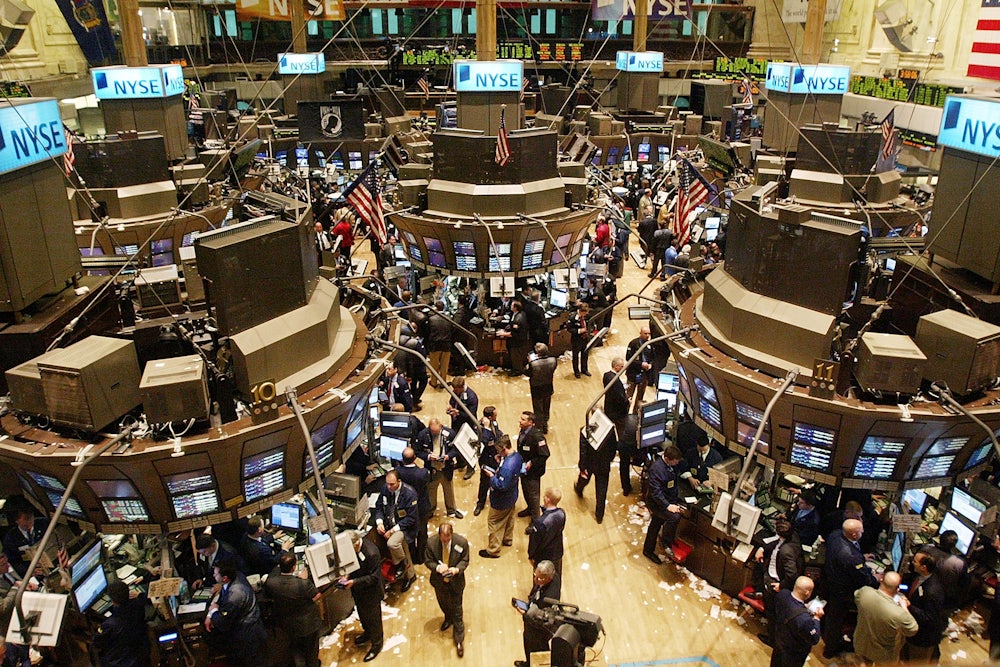Six months ago, people were very worried about the stock market. In January, it was rocketing upwards, thanks in part to a $1.5 trillion Republican tax bill that gave away hundreds of billions of dollars to the wealthy and to corporations. And then, on February 5, it all seemed like it was going to fall apart: The Dow Jones plunged 1,175 points, the largest single-day drop in history. Was this the beginning of the end of a near-decade-long bull market?
Not quite. While the Dow Jones hasn’t quite recovered from February’s plunge—it currently sits about 1,000 points lower than it did before the drop—the bull market persists. On Wednesday, it became (by some measures, anyway) the longest in United States history, having begun on March 9, 2009, and lasted 3,453 days. There are warning signs—including an escalating trade war and the possibility of a recession on the horizon—and some analysts believe that losses are imminent. But there’s also a strong case to be made that the bull market isn’t ending anytime soon.
President Donald Trump has been fond of pointing to the market as evidence of his masterful economic stewardship. But the bull market is also a window into the economy’s response to the 2008 financial crash, revealing just how incomplete the recovery has been and how few have felt the gains from the ongoing rally.
As Axios’s Steve LeVine argued earlier this week, this bull market is “not self-propelled.” Few are, but this one in particular was fueled by historically low interest rates, part of the Federal Reserve’s attempt to juice the economy in response to the Great Recession. The Fed has begun to raise interest rates, leading to criticism from Trump and extreme anxiety from investors on Wall Street. (Fear of rising interest rates was one of the causes of February’s dip.) This economic boom has been highly dependent on low global real interest rates, and it has been shown to be fragile whenever interest rates begin to climb.
At the same time, the Republican tax bill, passed at the end of 2017, pushed corporate profits to new heights. Combined with the Trump administration undoing of a number of financial regulations, it fed more fuel to the fire. But the tax bill redistributed tax dollars to a class that was already doing well, which means the gains in the stock market feel like empty calories. And instead of investing in workers or production, corporations are hoarding cash and buying back their own stock.
For all its strength, the bull market cannot hide some of the economy’s underlying weaknesses. The last nine years of stock market growth have also coincided with persistent anxiety about the state of the global economy. The S&P 500 fell over 20 percent (on an intraday basis) between May and October of 2011, thanks in part to the eurozone crisis. Two years ago, crises flared up in Brazil, Russia, and South Africa. Turkey is in the midst of a currency crisis, in part thanks to investors flooding the region in search of yield in an era of low interest rates. With interest rates rising, Turkey’s economy is buckling.
All of this points to a global economy that still has the jitters from 2008. The United States is no different. The benefits of the bull market have hardly been evenly distributed. Nearly two-thirds of Americans owned stock before the 2008 collapse; only 54 percent do now. A 2017 Gallup survey found that “89 percent of families with incomes over $100,000 have at least some money in the stock market, compared with just 21 percent of households earning $30,000 or less.” The richest 10 percent of Americans, meanwhile, own nearly 85 percent of stocks.
Wage growth hasn’t correlated with the S&P 500 in four decades; in any case, wages are stuck. And with stocks at historic highs, many Americans are unable to enter the market.
In terms of economic policy, the Trump administration has largely focused on corporate interests first, everything else second. Even when it was clear that the stock market was roaring, as it was in the fall of 2017, Republicans doubled down on corporate growth, arguing that it would improve the health of the economy as a whole. While most indicators show that the economy is doing pretty well, it’s clear that only part of the country is benefiting. “We have a ‘Two Realities’ economy in America,” William Rodgers, chief economist at the Heldrich Center for Workforce Development, told The Washington Post. “One segment has truly recovered from the Great Recession and is at full employment. The other continues to experience stagnating wages, involuntary part-time employment, inflexible work schedules, and weaker access to health care.”
Many will use the bull market’s milestone as an opportunity to spike the football. But if times are very good in corporate America, that’s not necessarily the case for everyone else.
